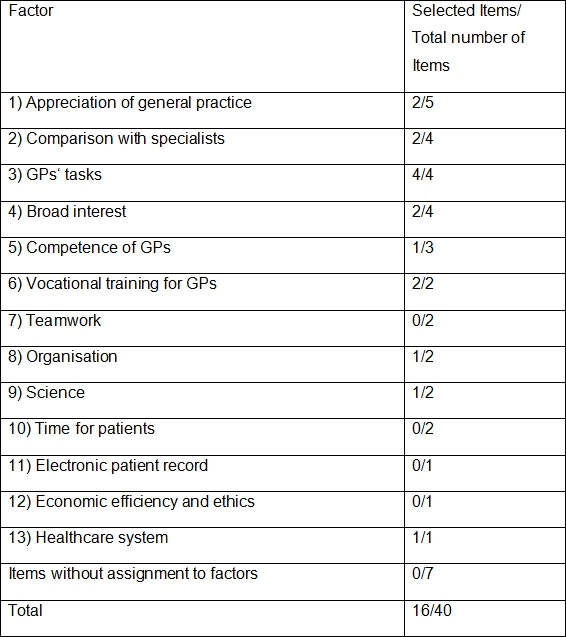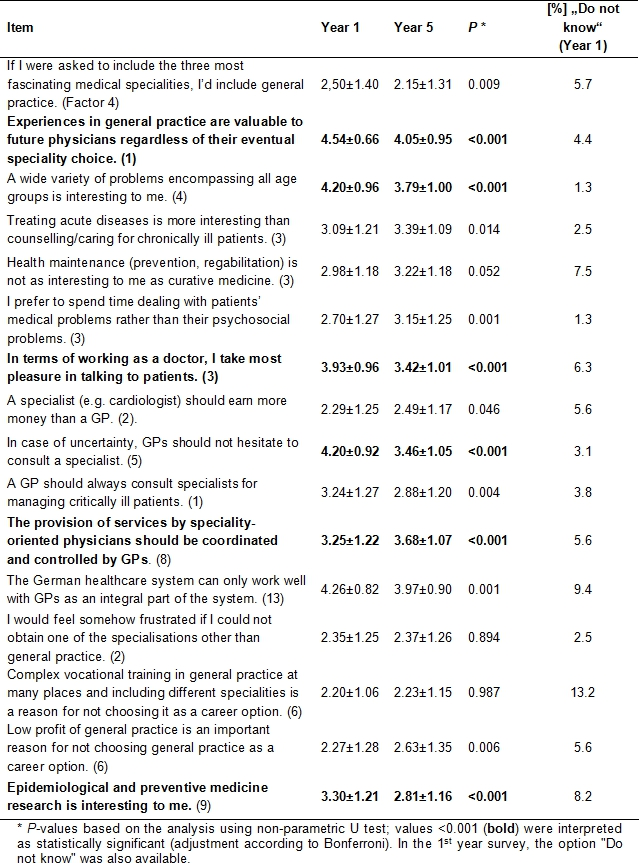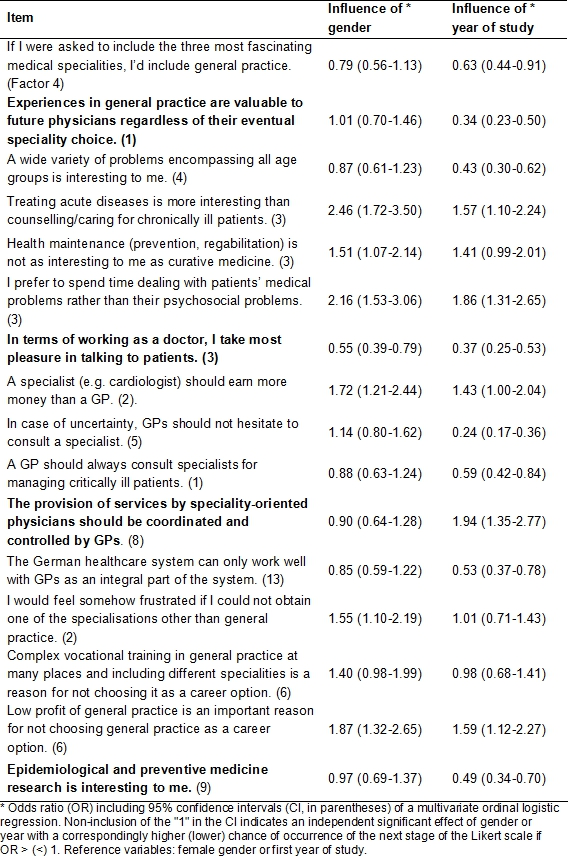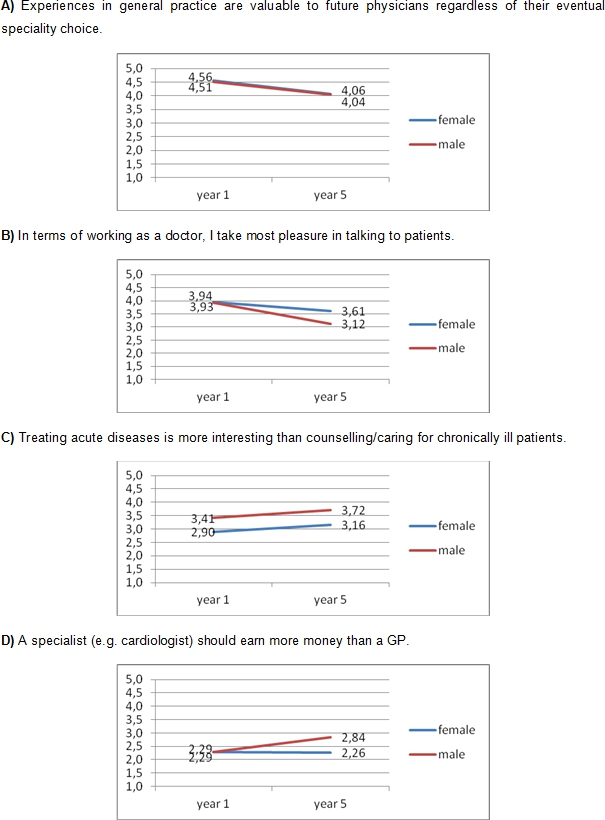[Attitudes towards General Practice: a comparative cross-sectional survey of 1st and 5th year medical students]
Carsten Kruschinski 1Birgitt Wiese 2
Eva Hummers-Pradier 3
1 Hannover Medical School, Institute of General Practice, Hannover, Germany
2 Hannover Medical School, Institute of Biometry, Hannover, Germany
3 University Medicine Göttingen, Department of General Practice/Family Medicine, Göttingen, Germany
Abstract
Objective: Positive attitudes towards General Practice can be understood as a prerequisite for becoming a General Practitioner (GP) and for collaboration with GPs later on. This study aimed to assess attitudes of medical students at the beginning and the end of medical school.
Methods: A total of 160 1
Results: Year of study and gender both were associated with the attitudes towards General Practice. The interest in General Practice and patient-orientation (communication, care of older patients with chronic diseases) was higher in 1
Conclusion: Despite some limitations caused by the cross-sectional design, the attitudes towards General Practice competencies changed to their disadvantage during medical school. This suggests a formative influence of the strategies used in medical education. Educational strategies, however, could be used to bring about a change of attitudes in the other direction.
Keywords
General Practice, Medical Education Research, Survey, Competencies, Attitudes
Introduction
The shortage of general and rural doctors is often reported. In order to identify possible causes, the training and the registration requirements which could be deterring potential candidates are regularily scrutinised. As a consequence, the training in many areas has been restructured via the creation of vocational training collaborations (Weiterbildungsverbünde) with fixed rotations from the beginning, which are supported by structured, content-related seminars [1], [2], [3].
In this country, the causes of primary care talent shortage have less often been studied in medical school itself. From abroad, it is known that role models for potential career paths are important during this period [4], [5]. Also early and, if possible, prolonged contact with general practice [4], [6] can positively influence the choice towards primary care training. However, differences in higher education and health systems limit the transferability of these findings from abroad. A more recent survey regarding the career plans of a large sample of medical students in Baden-Württemberg (n=1,299) describes the importance of concrete activity- and personality-related factors [7], such as an interest in patient orientation, which was associated with the career choice of family doctor.
This publication focuses more on the basic attitudes of medical students towards general practice. Attitudes (so-called affective learning goals) together with knowledge and practical skills (including communication) represent one of the three educational objectives in the study of medicine [8]. Attitudes are already "brought" from school and previous experience but these change during study through the continuing maturation of these young adults, but can also be consciously shaped through the use of intended learning goals by the faculty. A positive attitude towards general practice, is taken as a prerequisite for the choice of a general practice career goal in this study [9], [10] and is a desirable educational goal given the need for subsequent inter-professional collaboration. For these reasons, the attitudes of medical students at the MHH in their 1
Methods
Study design, participants and procedure
For the study, a survey of attitudes to general practice was undertaken in the form of a written questionnaire. For this publication, students in the 1st academic year at MHH were surveyed before their first lectures during the “Introduction Week” in October 2011. These results are compared to previously published results of students surveyed during their 5th academic year in the period 2008-2010 [11]. We therefore present a comparative cross-sectional study, as the same individuals were not followed over time.
In the 1
The survey of n=287 participants in the 5th academic year is described in detail elsewhere [11]: The respondents were from a total of 5 trimesters from 2 consecutive academic years (participation rate: 67.8%). Questionnaires were always distributed at the beginning of the block practical in general practice as part of the introduction held in the auditorium as well as a few weeks after the end of the block placement for pre-/post-comparison. Only the baseline data from the 5
The study design for the 5
Design of the questionnaire
The questionnaire and its development is discussed in detail in [11]. The questionnaire included a number of socio-demographic characteristics such as age, sex, origin (eg country, city), and details of the Abitur final grade, previous qualifications and planned field of study (see Table 1 [Tab. 1]). The question regarding experience in general practice (eg electives) was omitted from this current survey as it was designed for first year students.

The questionnaire also included another 39 real "attitude items". After an extensive literature review some questionnaires previously only used abroad were identified [11], examined, compared and a selection of relevant items made. These were translated into German and simultaneously culturally adapted. Of these translations, reciprocal translations into English were also prepared in order to identify possible distortions of meaning.
Compared to the survey given to the 5
This publication presents a selection of particularly relevant attitude items in tablular format. Choices were made for reasons of space and content overlap. A factor analysis was carried out in order to identify and group similar items [11]. This analysis identified 13 factors - as shown in Table 2 [Tab. 2] that reflected the different aspects of the questionnaire. These form the basis for the selection of items presented in Tables 3 [Tab. 3] and 4 [Tab. 4], with as many aspects of the questionnaire presented. The focus was kept specifically on the possible attitudes of the medical students in terms of concrete primary care working situations. As an example, this was not applicable for the item relating to electronic patient records [factor = 11], which is therefore not shown here.



Statististical analyses
Socio-demographic characteristics and all other data were analysed using descriptive statistics (mean, standard deviation, percentage).
Attitude items were analysed and reported using descriptive statistics (represented by the mean of the Likert scale scores). The results of the 1
In a multivariate analysis, the gender of the participants was considered alongside the academic year (1

Results
Characterisation of the study participants
By comparison to the 5
Differences in attitude between the 1st and 5th years of study
Significant differences (defined as p<0.001) were found in 8 (20.5%) of the 39 items requested. A selection of the items, identified according to the criteria described in the Methods section, are shown in Table 3 [Tab. 3].
Already in the 1
Similar opinions were also reflected in items not presented here. For example, the question of whether the treatment of acute symptoms is more interesting than the care of chronically ill patients (1
Coordination and filter functions of primary care physicians were rated less important by the younger students. The interest in research was less pronounced in the 5
Differences in attitude between men and women
The attitude towards general practice of men and women in the 1st academic year was comparable (Examples A, B and D in Figure 1 [Fig. 1]). In the 5
This association is shown as an example for some items and is illustrated in Figure 1 [Fig. 1]. With a "gap" (B, D) or with more distant but parallel curves (C), a gender effect is apparant in addition to a time effect represented byincreasing/decreasing curves. The gender effect involved many of the substantial conversational and psycho-social aspects, including the care of chronically ill patients.Men in the 5
Discussion
Summary of the main results
This survey of medical students presents a comprehensive picture of a variety of attitudes of first year students to general practice and the relevant associated competencies. Compared to another cohort of students in their 5
Comparison with the literature
Fundamentally, this discussion is based on the assumption that a positive attitude towards general practice is a crucial prerequisite for the intended career of general practicioner [9], [10]. Attitudes are thus understood to represent mouldable educational objectives of medical studies [5], [8], [9]. The following discussion therefore focuses on those determinants of career choice, which could be influenced by medical education.
Existing values present upon entry into the study of medicine can correlate with the subsequent career choice of GP. This is reflected by the expectation of a high income, research interest (negatively correlated, respectively) and a favourable assessment of the importance of primary care physicians (positively correlated) [4]. In part, candidate selection during admission interviews focusing either on social skills or an interest in basic scientific research could influence the choice of students that are more or less inclined to general practice.
Fundamentally, the extent of general practice teaching (particularly in the third and fourth years) correlates with the decision to pursue the subject [4], [6]. Generally, real practical experiences in primary care are valuable, in order to favourably affect attitudes towards the subject and at the same time encourage those to become a general practicioner [11], [12], [13], [14], [15]. This supports current efforts to extend the prescribed time devoted to the general medical training module to two weeks [16]. It is interesting that the attitudes towards GPs reported in two studies from the United Kingdom improved between the 1
Assumptions regarding the characteristics of a subject, for example, the fear of being intellectually understimulated [4], [18] or a poor reputation [4], also play a role in career considerations. This suggests that students during training should be well informed regarding the profession of general practice and misconceptions should be corrected and positive role models provided [19], [20]. However, our data suggests that feeling undervalued or even reduced earnings was not a significant argument against the choice of a general practice, it was however more generally true for men than women. At 5 sites surveyed in Germany, students’ “career ambitions“ (with respect to research) was less important amongst those who wanted to be GPs. However, "patient orientation" (interest in long term relationships with patients and preventative medicine) played a greater role [7] (also for example [21]). Such attitudes examined by us in greater detail seem to develop to the disadvantage of general practice towards the end of the course of study.
Open-mindedness, particularly towards psychosocial aspects of medicine [21], unfortunately was less pronounced as students approached their final practical study year. Longer periods of training in general practice as described above serve to regularly nurture and promote distinctive characteristics and interests of medical students in favour of a career in primary care. This was also the case in our first pre-/post-questionnaire (before and after the 3-week general practice clerkship) in the 5
Strengths and weaknesses
Overall, data from nearly 450 students have entered into the analysis described here. Although not a multicentre survey (as currently in Spain [22]), it was conducted at very different stages of training: at the beginning and in the penultimate year of study. This allowed analysis of possibly changing attitudes over almost the entire theoretical education. The differences between years could be due to a priori differences in attitude in the surveyed cohorts. However, excluding the age difference which was of course linked to progression through study, charcteristics such as gender, school grade and origin showed only small differences between groups. Ultimately, the present cross-sectional study using a historical comparison group can only provide an indication, which needs to be reviewed longitudinally.
On the positive side is the use of items already proven and partially validated abroad, which have been refined in multiple review processes [11]. The survey, based on a large number of items showed a coherent picture (face validity). However, a simplification and formal validation of our German questionnaire is still pending.
Conclusions
Our empirical study provides strong evidence of different attitudes of male and female medical students at the beginning and end of their training. This conclusion is limited by the cross-sectional design of the survey and should be examined longitudinally. During the course of study, positive views of general practice should be delivered in order not only to promote the career choice of the subject but also the subsequent inter-professional cooperation. This applies to efforts such as continuous training in psychosocial skills [23] and having the highest proportion possible of the general practice in the course e.g. in the form of longitudinal scale programmes [15], [24] such as the primary care Witten-Herdecke adoption programme [25]. It will be necessary to evaluate the extent to which such measures could also help to modify attitudes in Germany and to generate more recruits for general practice.
Acknowledgement
We thank all medical students that participated in the survey.
Competing interests
The authors declare that they have no competing interests.
References
[1] Steinhäuser J, Roos M, Haberer K, Ledig T, Peters-Klimm F, Szecsenyi J, Joos S. Bericht aus der Praxis: Das Programm Verbundweiterbildungplus des Kompetenzzentrums Allgemeinmedizin Baden-Württemberg - Entwicklung, Umsetzung und Perspektiven. Z Evid Fortbild Qual Gesundhwes. 2011;105(2):105-109. DOI: 10.1016/j.zefq.2011.02.002[2] Hummers-Pradier E, Schmiemann G. Besser im Verbund. Ein Modellprojekt zur inhaltlichen Begleitung der Verbundweiterbildung Allgemeinmedizin. Nds Arztebl. 2011;84:60-61.
[3] Korzilius H. Weiterbildung Allgemeinmedizin: Verbünde schaffen eine neue Weiterbildungskultur. Dtsch Arztebl. 2012;109(10):A464-A465.
[4] Senf JH, Campos-Outcalt D, Kutob R. Factors related to the choice of family medicine: a reassessment and literature review. J Am Board Fam Pract. 2003;16(6):502-512. DOI: 10.3122/jabfm.16.6.502
[5] Scott I, Wright B, Brenneis F, Brett-MacLean P, McCaffrey L. Why would I choose a career in family medicine? Reflections of medical students at 3 universities. Can Fam Physician. 2007;53(11):1956-1957.
[6] Howe A, Ives G. Does community-based experience alter career preference? New evidence from a prospective longitudinal cohort study of undergraduate medical students. Med Educ. 2001;35(4):391-397. DOI: 10.1046/j.1365-2923.2001.00866.x
[7] Kiolbassa K, Miksch A, Hermann K, Loh A, Szecsenyi J, Joos S, Goetz K. Becoming a general practitioner - Which factors have most impact on career choice of medical students? BMC Fam Pract. 2011;12:25. DOI: 10.1186/1471-2296-12-25
[8] Kern DE, Thomas PA, Howard DM, Bass EB. Curriculum development for medical education - A six-step approach. Baltimore: The John Hopkins University Press; 1998. p.28-37.
[9] Henderson E, Berlin A, Fuller J. Attitude of medical students towards general practice and general practitioners. Br J Gen Pract. 2002;52(478):359-363.
[10] Block SD, Clark-Chiarelli N, Singer JD. Mixed messages about primary care in the culture of U.S. medical schools. Acad Med. 1998;73(10):1087-1094. DOI: 10.1097/00001888-199810000-00020
[11] Kruschinski C, Wiese B, Eberhard J, Hummers-Pradier E. Einstellungen von Studierenden zur Allgemeinmedizin: Einflüsse von Geschlecht, Blockpraktikum und Gesamtcurriculum. GMS Z Med Ausbild. 2011;28(1):Doc16. DOI: 10.3205/zma000728
[12] Duerson MC, Crandall LA, Dwyer JW. Impact of a required family medicine clerkship on medical students' attitudes about primary care. Acad Med. 1989;64(9):546-548. DOI: 10.1097/00001888-198909000-00014
[13] Schäfer HM, Sennekamp M, Güthlin C, Krentz H, Gerlach FM. Kann das Blockpraktikum Allgemeinmedizin zum Beruf des Hausarztes motivieren? Z Allg Med. 2009;85(5):206-209.
[14] Dunker-Schmidt C, Breetholt A, Gesenhues S. Blockpraktikum in der Allgemeinmedizin: 15 Jahre Erfahrung an der Universität Duisburg-Essen. Z Allg Med. 2009;85(4):170-175.
[15] Sinclair HK, Ritchie LD, Lee AJ. A future career in general practice? A longitudinal study of medical students and pre-registration house officers. Eur J Gen Pract. 2006;12(3):120-127. DOI: 10.1080/13814780600780833
[16] Richter-Kuhlmann E, Stüwe H. Interview mit Dr. Frank-Ulrich Montgomery. Dtsch Arztebl. 2012;109(3):A71-72.
[17] Furmedge DS. General practice stigma at medical school and beyond - do we need to take action? Br J Gen Pract. 2008;58(553):581. DOI: 10.3399/bjgp08X319774
[18] Shadbolt N, Bunker J. Choosing general practice - review of career choice determinants. Aust Fam Physician. 2009;38(1-2):53-55.
[19] Schwartz MD, Basco WT, Grey MR, Elmore JG, Rubenstein A. Rekindling student interest in generalist careers. Ann Intern Med. 2005;142(8):715-724.
[20] Miettola J, Mäntyselkä P, Vaskilampi T. Doctor-patient interaction in Finnish primary health care as perceived by first year medical students. BMC Med Educ. 2005;5:34. DOI: 10.1186/1472-6920-5-34
[21] Scott I, Gowans M, Wright B, Brenneis F, Banner S, Boone J. Determinants of choosing a career in family medicine. CMAJ. 2011;183(1):E1-E8. DOI: 10.1503/cmaj.091805
[22] Alonso-Coello P, Villa JJ, Hijar AM, Tuduri XM, Puime AO, Zurro AM. Attitudes and perceptions of medical students about family medicine in Spain: protocol for a cross-sectional survey. BMJ Open. 2011;1(2):e000231. DOI: 10.1136/bmjopen-2011-000231
[23] Bachmann C, Hölzer H, Dieterich A, Fabry G, Langewitz W, Lauber H, Ortwein H, Pruskil S, Schubert S, Sennekamp M, Simmenroth-Nayda A, Silbernagel W, Scheffer S, Kiessling C. Longitudinales Bologna-kompatibles Modell-Curriculum kommunikative und soziale Kompetenzen": Ergebnisse eines interdisziplinären Workshops deutschsprachiger medizinischer Fakultäten. GMS Z Med Ausbild. 2009;26(4):Doc38. DOI: 10.3205/zma000631
[24] Trachsel S, Schaufelberger M, Feller S, Küng L, Frey P, Guttormsen Schär S. Evaluation eines neuen Mentoring-Programms für Medizinstudierende in der hausärztlichen Grundversorgung: Erfahrungen von Studierenden und Lehrärzten. GMS Z Med Ausbild. 2010;27(3):Doc42. DOI: 10.3205/zma000679
[25] Hibbeler B. Allgemeinmedizin im Studium. Ab in die Praxis! Dtsch Arztebl. 2010;107(46):A2284-A2285.




